Zhouhui Lian
UTDesign: A Unified Framework for Stylized Text Editing and Generation in Graphic Design Images
Dec 23, 2025Abstract:AI-assisted graphic design has emerged as a powerful tool for automating the creation and editing of design elements such as posters, banners, and advertisements. While diffusion-based text-to-image models have demonstrated strong capabilities in visual content generation, their text rendering performance, particularly for small-scale typography and non-Latin scripts, remains limited. In this paper, we propose UTDesign, a unified framework for high-precision stylized text editing and conditional text generation in design images, supporting both English and Chinese scripts. Our framework introduces a novel DiT-based text style transfer model trained from scratch on a synthetic dataset, capable of generating transparent RGBA text foregrounds that preserve the style of reference glyphs. We further extend this model into a conditional text generation framework by training a multi-modal condition encoder on a curated dataset with detailed text annotations, enabling accurate, style-consistent text synthesis conditioned on background images, prompts, and layout specifications. Finally, we integrate our approach into a fully automated text-to-design (T2D) pipeline by incorporating pre-trained text-to-image (T2I) models and an MLLM-based layout planner. Extensive experiments demonstrate that UTDesign achieves state-of-the-art performance among open-source methods in terms of stylistic consistency and text accuracy, and also exhibits unique advantages compared to proprietary commercial approaches. Code and data for this paper are available at https://github.com/ZYM-PKU/UTDesign.
IndoorUAV: Benchmarking Vision-Language UAV Navigation in Continuous Indoor Environments
Dec 22, 2025Abstract:Vision-Language Navigation (VLN) enables agents to navigate in complex environments by following natural language instructions grounded in visual observations. Although most existing work has focused on ground-based robots or outdoor Unmanned Aerial Vehicles (UAVs), indoor UAV-based VLN remains underexplored, despite its relevance to real-world applications such as inspection, delivery, and search-and-rescue in confined spaces. To bridge this gap, we introduce \textbf{IndoorUAV}, a novel benchmark and method specifically tailored for VLN with indoor UAVs. We begin by curating over 1,000 diverse and structurally rich 3D indoor scenes from the Habitat simulator. Within these environments, we simulate realistic UAV flight dynamics to collect diverse 3D navigation trajectories manually, further enriched through data augmentation techniques. Furthermore, we design an automated annotation pipeline to generate natural language instructions of varying granularity for each trajectory. This process yields over 16,000 high-quality trajectories, comprising the \textbf{IndoorUAV-VLN} subset, which focuses on long-horizon VLN. To support short-horizon planning, we segment long trajectories into sub-trajectories by selecting semantically salient keyframes and regenerating concise instructions, forming the \textbf{IndoorUAV-VLA} subset. Finally, we introduce \textbf{IndoorUAV-Agent}, a novel navigation model designed for our benchmark, leveraging task decomposition and multimodal reasoning. We hope IndoorUAV serves as a valuable resource to advance research on vision-language embodied AI in the indoor aerial navigation domain.
MMMG: A Massive, Multidisciplinary, Multi-Tier Generation Benchmark for Text-to-Image Reasoning
Jun 12, 2025Abstract:In this paper, we introduce knowledge image generation as a new task, alongside the Massive Multi-Discipline Multi-Tier Knowledge-Image Generation Benchmark (MMMG) to probe the reasoning capability of image generation models. Knowledge images have been central to human civilization and to the mechanisms of human learning--a fact underscored by dual-coding theory and the picture-superiority effect. Generating such images is challenging, demanding multimodal reasoning that fuses world knowledge with pixel-level grounding into clear explanatory visuals. To enable comprehensive evaluation, MMMG offers 4,456 expert-validated (knowledge) image-prompt pairs spanning 10 disciplines, 6 educational levels, and diverse knowledge formats such as charts, diagrams, and mind maps. To eliminate confounding complexity during evaluation, we adopt a unified Knowledge Graph (KG) representation. Each KG explicitly delineates a target image's core entities and their dependencies. We further introduce MMMG-Score to evaluate generated knowledge images. This metric combines factual fidelity, measured by graph-edit distance between KGs, with visual clarity assessment. Comprehensive evaluations of 16 state-of-the-art text-to-image generation models expose serious reasoning deficits--low entity fidelity, weak relations, and clutter--with GPT-4o achieving an MMMG-Score of only 50.20, underscoring the benchmark's difficulty. To spur further progress, we release FLUX-Reason (MMMG-Score of 34.45), an effective and open baseline that combines a reasoning LLM with diffusion models and is trained on 16,000 curated knowledge image-prompt pairs.
TextFlux: An OCR-Free DiT Model for High-Fidelity Multilingual Scene Text Synthesis
May 23, 2025

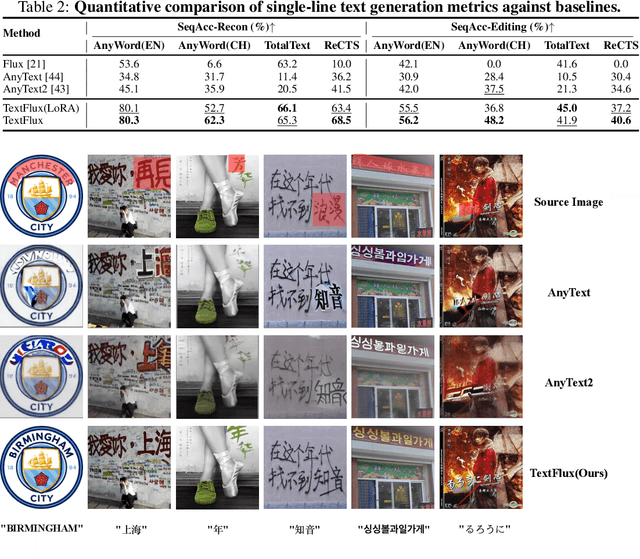
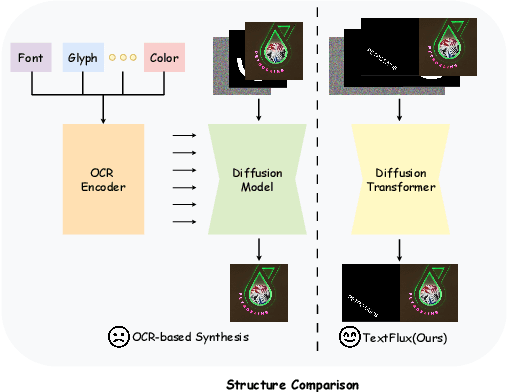
Abstract:Diffusion-based scene text synthesis has progressed rapidly, yet existing methods commonly rely on additional visual conditioning modules and require large-scale annotated data to support multilingual generation. In this work, we revisit the necessity of complex auxiliary modules and further explore an approach that simultaneously ensures glyph accuracy and achieves high-fidelity scene integration, by leveraging diffusion models' inherent capabilities for contextual reasoning. To this end, we introduce TextFlux, a DiT-based framework that enables multilingual scene text synthesis. The advantages of TextFlux can be summarized as follows: (1) OCR-free model architecture. TextFlux eliminates the need for OCR encoders (additional visual conditioning modules) that are specifically used to extract visual text-related features. (2) Strong multilingual scalability. TextFlux is effective in low-resource multilingual settings, and achieves strong performance in newly added languages with fewer than 1,000 samples. (3) Streamlined training setup. TextFlux is trained with only 1% of the training data required by competing methods. (4) Controllable multi-line text generation. TextFlux offers flexible multi-line synthesis with precise line-level control, outperforming methods restricted to single-line or rigid layouts. Extensive experiments and visualizations demonstrate that TextFlux outperforms previous methods in both qualitative and quantitative evaluations.
Creating Your Editable 3D Photorealistic Avatar with Tetrahedron-constrained Gaussian Splatting
Apr 29, 2025



Abstract:Personalized 3D avatar editing holds significant promise due to its user-friendliness and availability to applications such as AR/VR and virtual try-ons. Previous studies have explored the feasibility of 3D editing, but often struggle to generate visually pleasing results, possibly due to the unstable representation learning under mixed optimization of geometry and texture in complicated reconstructed scenarios. In this paper, we aim to provide an accessible solution for ordinary users to create their editable 3D avatars with precise region localization, geometric adaptability, and photorealistic renderings. To tackle this challenge, we introduce a meticulously designed framework that decouples the editing process into local spatial adaptation and realistic appearance learning, utilizing a hybrid Tetrahedron-constrained Gaussian Splatting (TetGS) as the underlying representation. TetGS combines the controllable explicit structure of tetrahedral grids with the high-precision rendering capabilities of 3D Gaussian Splatting and is optimized in a progressive manner comprising three stages: 3D avatar instantiation from real-world monocular videos to provide accurate priors for TetGS initialization; localized spatial adaptation with explicitly partitioned tetrahedrons to guide the redistribution of Gaussian kernels; and geometry-based appearance generation with a coarse-to-fine activation strategy. Both qualitative and quantitative experiments demonstrate the effectiveness and superiority of our approach in generating photorealistic 3D editable avatars.
CalliReader: Contextualizing Chinese Calligraphy via an Embedding-Aligned Vision-Language Model
Mar 09, 2025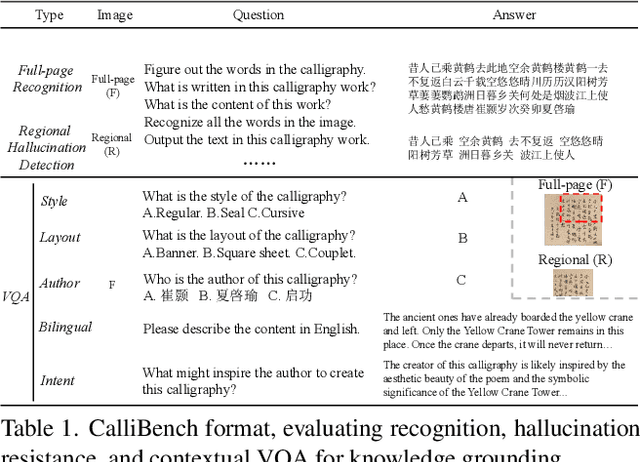
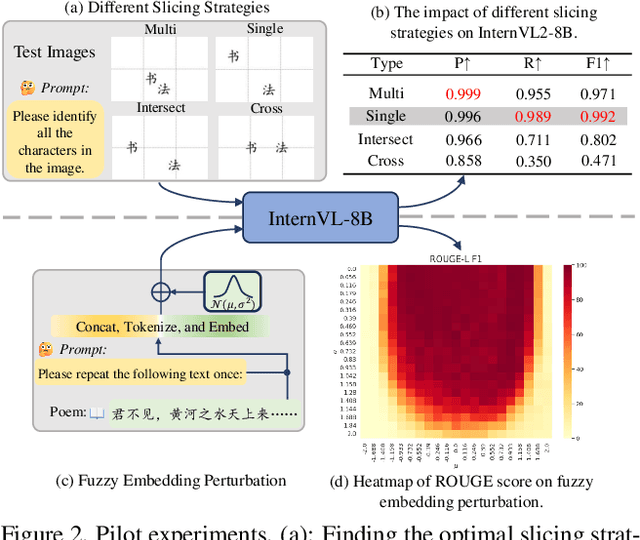
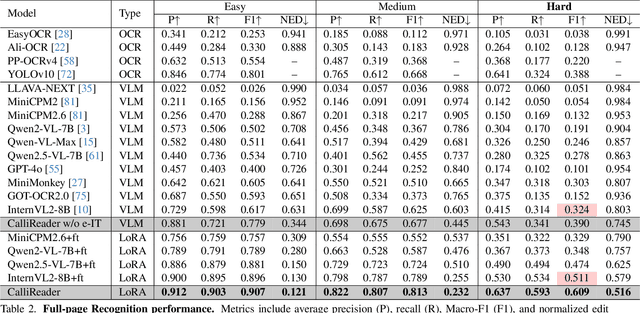
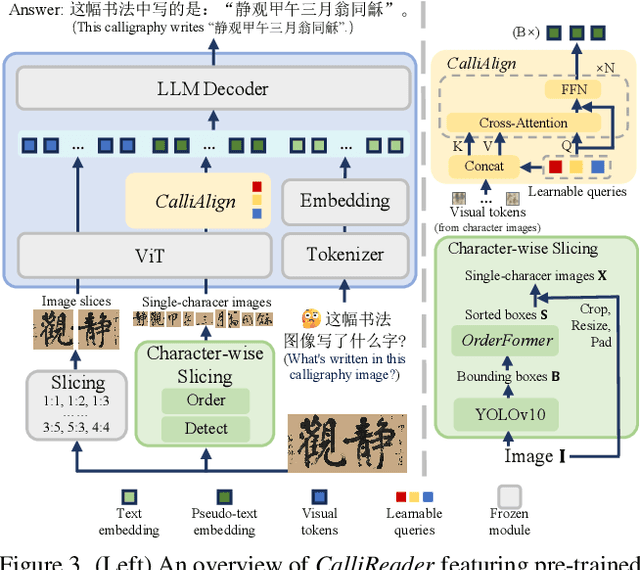
Abstract:Chinese calligraphy, a UNESCO Heritage, remains computationally challenging due to visual ambiguity and cultural complexity. Existing AI systems fail to contextualize their intricate scripts, because of limited annotated data and poor visual-semantic alignment. We propose CalliReader, a vision-language model (VLM) that solves the Chinese Calligraphy Contextualization (CC$^2$) problem through three innovations: (1) character-wise slicing for precise character extraction and sorting, (2) CalliAlign for visual-text token compression and alignment, (3) embedding instruction tuning (e-IT) for improving alignment and addressing data scarcity. We also build CalliBench, the first benchmark for full-page calligraphic contextualization, addressing three critical issues in previous OCR and VQA approaches: fragmented context, shallow reasoning, and hallucination. Extensive experiments including user studies have been conducted to verify our CalliReader's \textbf{superiority to other state-of-the-art methods and even human professionals in page-level calligraphy recognition and interpretation}, achieving higher accuracy while reducing hallucination. Comparisons with reasoning models highlight the importance of accurate recognition as a prerequisite for reliable comprehension. Quantitative analyses validate CalliReader's efficiency; evaluations on document and real-world benchmarks confirm its robust generalization ability.
ART: Anonymous Region Transformer for Variable Multi-Layer Transparent Image Generation
Feb 25, 2025Abstract:Multi-layer image generation is a fundamental task that enables users to isolate, select, and edit specific image layers, thereby revolutionizing interactions with generative models. In this paper, we introduce the Anonymous Region Transformer (ART), which facilitates the direct generation of variable multi-layer transparent images based on a global text prompt and an anonymous region layout. Inspired by Schema theory suggests that knowledge is organized in frameworks (schemas) that enable people to interpret and learn from new information by linking it to prior knowledge.}, this anonymous region layout allows the generative model to autonomously determine which set of visual tokens should align with which text tokens, which is in contrast to the previously dominant semantic layout for the image generation task. In addition, the layer-wise region crop mechanism, which only selects the visual tokens belonging to each anonymous region, significantly reduces attention computation costs and enables the efficient generation of images with numerous distinct layers (e.g., 50+). When compared to the full attention approach, our method is over 12 times faster and exhibits fewer layer conflicts. Furthermore, we propose a high-quality multi-layer transparent image autoencoder that supports the direct encoding and decoding of the transparency of variable multi-layer images in a joint manner. By enabling precise control and scalable layer generation, ART establishes a new paradigm for interactive content creation.
RSUniVLM: A Unified Vision Language Model for Remote Sensing via Granularity-oriented Mixture of Experts
Dec 10, 2024Abstract:Remote Sensing Vision-Language Models (RS VLMs) have made much progress in the tasks of remote sensing (RS) image comprehension. While performing well in multi-modal reasoning and multi-turn conversations, the existing models lack pixel-level understanding and struggle with multi-image inputs. In this work, we propose RSUniVLM, a unified, end-to-end RS VLM designed for comprehensive vision understanding across multiple granularity, including image-level, region-level, and pixel-level tasks. RSUniVLM also performs effectively in multi-image analysis, with instances of change detection and change captioning. To enhance the model's ability to capture visual information at different levels without increasing model size, we design a novel architecture called Granularity-oriented Mixture of Experts to constraint the model to about 1 billion parameters. We also construct a large-scale RS instruction-following dataset based on a variety of existing datasets in both RS and general domain, encompassing various tasks such as object localization, visual question answering, and semantic segmentation. Substantial experiments have been conducted to validate the superiority of the proposed RSUniVLM up to state-of-the-art across various RS tasks. Code and model will be available at \href{https://github.com/xuliu-cyber/RSUniVLM}{here}.
TexGaussian: Generating High-quality PBR Material via Octree-based 3D Gaussian Splatting
Nov 29, 2024


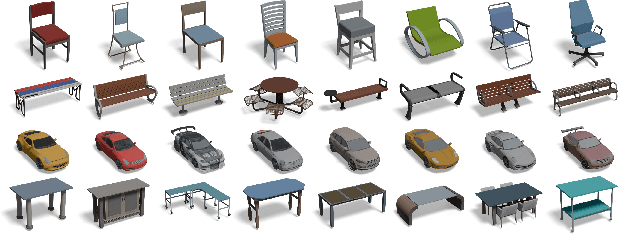
Abstract:Physically Based Rendering (PBR) materials play a crucial role in modern graphics, enabling photorealistic rendering across diverse environment maps. Developing an effective and efficient algorithm that is capable of automatically generating high-quality PBR materials rather than RGB texture for 3D meshes can significantly streamline the 3D content creation. Most existing methods leverage pre-trained 2D diffusion models for multi-view image synthesis, which often leads to severe inconsistency between the generated textures and input 3D meshes. This paper presents TexGaussian, a novel method that uses octant-aligned 3D Gaussian Splatting for rapid PBR material generation. Specifically, we place each 3D Gaussian on the finest leaf node of the octree built from the input 3D mesh to render the multiview images not only for the albedo map but also for roughness and metallic. Moreover, our model is trained in a regression manner instead of diffusion denoising, capable of generating the PBR material for a 3D mesh in a single feed-forward process. Extensive experiments on publicly available benchmarks demonstrate that our method synthesizes more visually pleasing PBR materials and runs faster than previous methods in both unconditional and text-conditional scenarios, which exhibit better consistency with the given geometry. Our code and trained models are available at https://3d-aigc.github.io/TexGaussian.
HFH-Font: Few-shot Chinese Font Synthesis with Higher Quality, Faster Speed, and Higher Resolution
Oct 09, 2024Abstract:The challenge of automatically synthesizing high-quality vector fonts, particularly for writing systems (e.g., Chinese) consisting of huge amounts of complex glyphs, remains unsolved. Existing font synthesis techniques fall into two categories: 1) methods that directly generate vector glyphs, and 2) methods that initially synthesize glyph images and then vectorize them. However, the first category often fails to construct complete and correct shapes for complex glyphs, while the latter struggles to efficiently synthesize high-resolution (i.e., 1024 $\times$ 1024 or higher) glyph images while preserving local details. In this paper, we introduce HFH-Font, a few-shot font synthesis method capable of efficiently generating high-resolution glyph images that can be converted into high-quality vector glyphs. More specifically, our method employs a diffusion model-based generative framework with component-aware conditioning to learn different levels of style information adaptable to varying input reference sizes. We also design a distillation module based on Score Distillation Sampling for 1-step fast inference, and a style-guided super-resolution module to refine and upscale low-resolution synthesis results. Extensive experiments, including a user study with professional font designers, have been conducted to demonstrate that our method significantly outperforms existing font synthesis approaches. Experimental results show that our method produces high-fidelity, high-resolution raster images which can be vectorized into high-quality vector fonts. Using our method, for the first time, large-scale Chinese vector fonts of a quality comparable to those manually created by professional font designers can be automatically generated.
 Add to Chrome
Add to Chrome Add to Firefox
Add to Firefox Add to Edge
Add to Edge